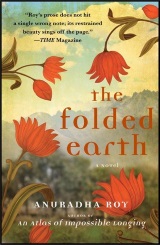The Folded Earth
Anuradha Roy

Paperback: 288 pages Publisher: Free Press(2012) Language: EnglishUS: AbeBooks, Amazon, Barnes&NobleUK: Amazon.uk, AbeBooks.co.ukPK: Liberty Books,IN: Full Circle Bookstore, Amazon.in |
This is Roy’s second novel, after An Atlas of Impossible Longing, and the writing style is clearly developing well, more controlled, and quite elegant. Roy’s charm is that although her novel is set firmly within particular geographical coordinates, she nevertheless is unself-conscious about being an Indian writing in English, and does not draw undue attention to this fact, nor does she exoticise India and Indians in any way. Instead of focusing on content, Roy’s novels focus on form, and it is very much to her credit that she uses the text to weave her atmosphere, rather than relying on clichés and exotica. The Folder Earth’s protagonist is Maya, a woman who breaks away from familial and societal expectations by eloping with a man of a different faith and estranging herself from her parents. The marriage is a success, except her husband dies young, and the novel is mostly about Maya’s manner of grieving and healing. She moves to Ranikhet, a small village in the mountains near where her husband died, moving from Hyderabad to the foothills of the Himalayas. There, Maya takes up a post as a school teacher, and her life soon encompasses several intriguing individuals. Chief amongst these is Charu, a village teenager, who falls in love and discovers her need for literacy. Diwan Sahib is another of these intriguing characters, an old man now, frail and crusty, but one of lingering glories and exhibiting frequent bursts of elegances and magnanimity. Roy’s characters endear themselves to the reader, and like her writing style, are charming, whimsical, sympathetic, and natural. Maya is an unusual protagonist, who is able to step out of the shackles of societal expectation, and is neither attempting to win anyone’s approval nor afraid of anyone’s opinion. She seems wholly independent, practically as well as spiritually, and remains at once detached and yet involved. She takes part in Ranikhet’s life and community with care and sincerity, with generosity and warmth, but is fiercely defensive of her privacy and grieves. She puts up emotional barriers, but remains vulnerable and therefore lovable. Maya seems to function as a law unto herself, and is an exceptional Indian protagonist, able to apparently simply step out of her cultural and societal networks, and simply exist within her own parameters. However, although its character depiction and development is extremely well executed, the novel needs a little more consistency; it meanders and goes off at tangents, and were it not for the charm of the writing style, it would have occasionally risked losing the reader. It indulges the descriptive to the extent that the plot is occasionally temporarily shelved; but Roy does return to pick up the thread of the plot again, and continue with this meandering story, which however meandering, never loses its charm. The ending however is strong and purposeful, where the plot comes into its own and loose ends are tied up. The strength of the conclusion is highly satisfactory, and rewards the reader for patience.
Lisa Lau is a lecturer and researcher in the UK. Her areas of interest include literature, contemporary cross-cultural fiction, South Asia, gender studies, diasporic communities, postcolonialism, cyberspace research, and cultural geographies. (SAWNET Review) ReviewsNY Times, June 2012 PopMatters, August 2012 The Independent, Feb 2011 |
